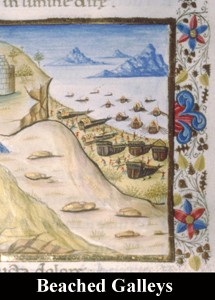In 1297 Roger decided to return to Aragon and accompanied Queen Constance and
James II to Rome where he
was rewarded with the title of Admiral of the Crown of Aragon and County
of Barcelona. Both James and the church
 wanted Roger's services for it was becoming clear that only force was
going to remove Frederick from Sicily. In the fall of 1298 the Angevins
moved into southern Italy and by the following spring had ejected
Sicilian forces from the peninsula. However, an assault against the island
resulted only in defeat. When James II and Robert Count of Calabria, the
eldest son of Charles II, had laid siege to Syracuse and Messina,
Frederick responded by driving James away from Syracuse while the Sicilian
fleet defeated the Aragonese fleet under the command of Roger's nephew,
John of Lauria, off Messina. The
Aragonese-Angevin forces had to withdraw, but Robert held on to Catania.
wanted Roger's services for it was becoming clear that only force was
going to remove Frederick from Sicily. In the fall of 1298 the Angevins
moved into southern Italy and by the following spring had ejected
Sicilian forces from the peninsula. However, an assault against the island
resulted only in defeat. When James II and Robert Count of Calabria, the
eldest son of Charles II, had laid siege to Syracuse and Messina,
Frederick responded by driving James away from Syracuse while the Sicilian
fleet defeated the Aragonese fleet under the command of Roger's nephew,
John of Lauria, off Messina. The
Aragonese-Angevin forces had to withdraw, but Robert held on to Catania.
The following year saw a renewal of the conflict with James II and Roger of Lauria leading a combined Aragonese-Angevin on an expedition against northern Sicily. When Roger left Sicily, Frederick III appointed the Genoese Conrad d'Oria as admiral of the Sicilian fleet. Conrad tried, but failed, to intercept Roger before the Aragonese-Angevin fleet beached itself stern-first at Cape Orlando. Pushed by charges of cowardice, on July 4, 1299 Conrad decided to attack the beached fleet against his better judgment. A beached fleet that was prepared had all of the advantages, including the ability to quickly transfer men. Moreover, Roger had 6 galleys hiding in a bay waiting to attack the Sicilians from the rear once their fleet had committed to the attack. Conrad's attack was disorganized and the result was the utter defeat of Frederick and his fleet, with only 13 of his 40 ships escaping.
Even more important is what did not happen at the battle. Surviving correspondence strongly suggests that James permitted his brother to escape the battle. Certainly the insignificant raids with which James followed up this success indicate a less than enthusiastic desire to prosecute the war on his part. In fact, not long after the Battle of Cape Orlando James II returned to Aragon taking the entire army with him after accusing the pope and Charles II of reneging on the promised monetary support. When James withdrew from the war, Frederick responded in November by routing an invasion force at Falconaria and taking captive its commander, Phillip of Taranto, the fourth son of Charles II.


